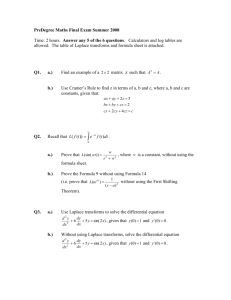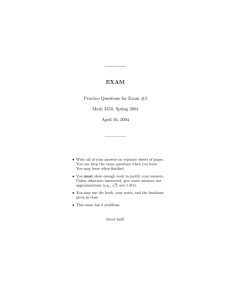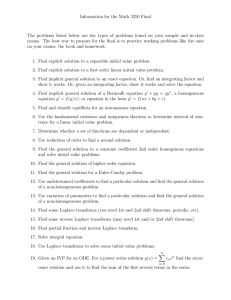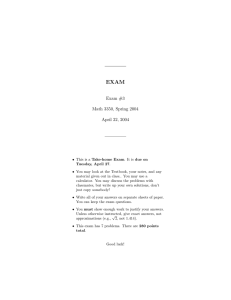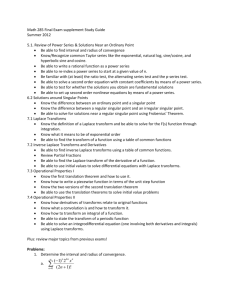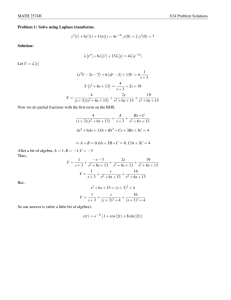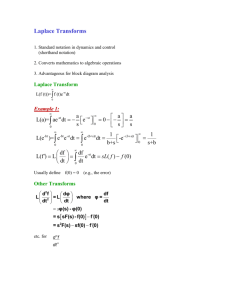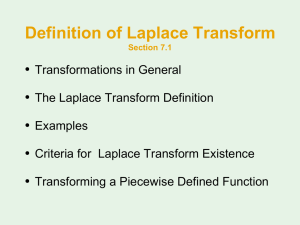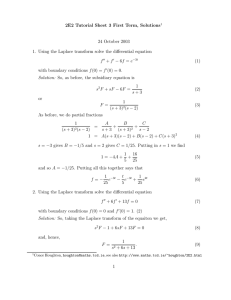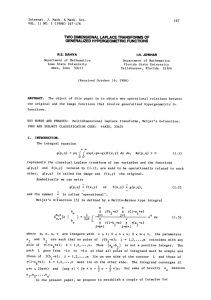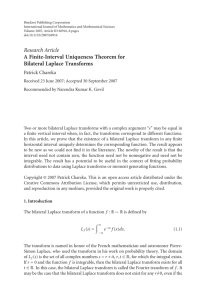SUMMARY OF LAPLACE TRANSFORMS L {f(t)} =
advertisement
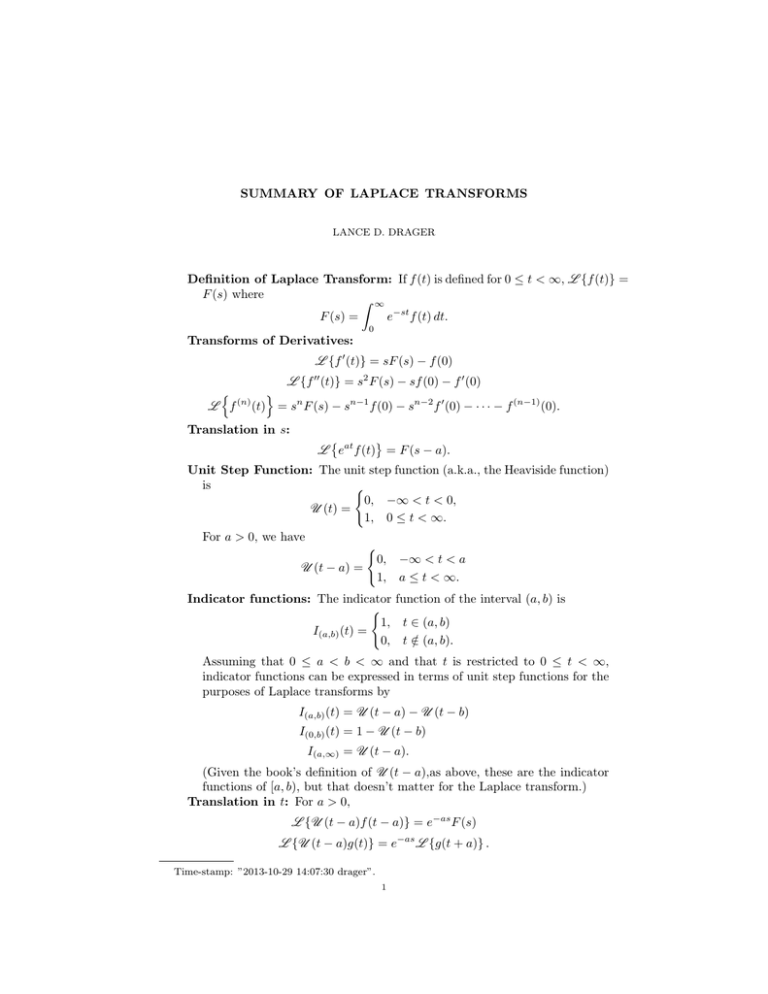
SUMMARY OF LAPLACE TRANSFORMS
LANCE D. DRAGER
Definition of Laplace Transform: If f (t) is defined for 0 ≤ t < ∞, L {f (t)} =
F (s) where
Z ∞
F (s) =
e−st f (t) dt.
0
Transforms of Derivatives:
L {f 0 (t)} = sF (s) − f (0)
L {f 00 (t)} = s2 F (s) − sf (0) − f 0 (0)
n
o
L f (n) (t) = sn F (s) − sn−1 f (0) − sn−2 f 0 (0) − · · · − f (n−1) (0).
Translation in s:
L eat f (t) = F (s − a).
Unit Step Function: The unit step function (a.k.a., the Heaviside function)
is
(
0, −∞ < t < 0,
U (t) =
1, 0 ≤ t < ∞.
For a > 0, we have
(
0, −∞ < t < a
U (t − a) =
1, a ≤ t < ∞.
Indicator functions: The indicator function of the interval (a, b) is
(
1, t ∈ (a, b)
I(a,b) (t) =
0, t ∈
/ (a, b).
Assuming that 0 ≤ a < b < ∞ and that t is restricted to 0 ≤ t < ∞,
indicator functions can be expressed in terms of unit step functions for the
purposes of Laplace transforms by
I(a,b) (t) = U (t − a) − U (t − b)
I(0,b) (t) = 1 − U (t − b)
I(a,∞) = U (t − a).
(Given the book’s definition of U (t − a),as above, these are the indicator
functions of [a, b), but that doesn’t matter for the Laplace transform.)
Translation in t: For a > 0,
L {U (t − a)f (t − a)} = e−as F (s)
L {U (t − a)g(t)} = e−as L {g(t + a)} .
Time-stamp: ”2013-10-29 14:07:30 drager”.
1
2
LANCE D. DRAGER
Derivatives of Transforms:
dn
F (s).
dsn
Transform of a Periodic Function: If f (t) has period T , then
Z T
1
L {f (t)} =
e−st f (t) dt.
1 − e−sT 0
L {tn f (t)} = (−1)n
Definition of Convolution: If f (t) and g(t) are defined for 0 ≤ t < ∞, then
f ∗ g is defined on the same t range by
Z t
Z t
g(τ )f (t − τ ) dτ,
f (τ )g(t − τ ) dτ =
(f ∗ g)(t) =
0
0
so f ∗ g = g ∗ f .
Convolution Theorem:
L {(f ∗ g)(t)} = F (s)G(s).
Transform of Integrals:
Z t
F (s)
L
f (τ ) dτ =
.
s
0
Transform of the Delta Function:
L {δ(t − a)} = e−as .
Impulse response function: Let P (s) be a polynomial of degree n. The
solution of the “formal” initial value problem
P (D)y = δ(t),
y(0) = 0, y 0 (0) = 0, . . . , y (n−1) (0) = 0
is
1
h(t) = L
,
P (s)
which is called the impulse response function of the operator P (D).
The solution of the initial value problem
−1
P (D)y = f (x),
y(0) = 0, y 0 (0) = 0, . . . , y (n−1) (0) = 0
(∗)
is
y(t) = L
−1
Z
{F (s)/P (s)} = (h ∗ f )(t) =
t
h(t − τ )f (τ ) dτ.
0
The solution of the homogeneous IVP
P (D)y = 0,
y(0) = A0 , y 0 (0) = A1 , . . . , y (n−1) (0) = An−1 ,
(∗∗)
is
g(t) = L −1 {Q(s)/P (s)}
for some polynomial Q(s) of degree n − 1 that you’d have to calculate. The
solution of the IVP
P (D)y = f (t),
y(0) = A0 , y 0 (0) = A1 , . . . , y (n−1) (0) = An−1
is the sum of the solutions to (∗) and (∗∗),
Z t
y(t) =
h(t − τ )f (τ ) dτ + g(t),
0
SUMMARY OF LAPLACE TRANSFORMS
3
where (of course) g(t) does not depend of f (t).
Short Table of Laplace Transforms
Ref.
f (t)
(1)
1
(2)
t
(3)
tn
(4)
eat
(5)
tn eat
(6)
cos(ωt)
(7)
sin(ωt)
(8)
eat cos(ωt)
(9)
eat sin(ωt)
(10)
t cos(ωt)
(11)
t sin(ωt)
(12)
sin(ωt) − ωt cos(ωt)
F (s)
1
s
1
s2
n!
sn+1
1
s−a
n!
(s − a)n+1
s
s2 + ω 2
ω
s2 + ω 2
s−a
(s − a)2 + ω 2
ω
(s − a)2 + ω 2
s2 − ω 2
(s2 + ω 2 )2
2ωs
2
(s + ω 2 )2
(s2
2ω 3
+ ω 2 )2
Department of Mathematics and Statistics, Texas Tech University, Lubbock, TX
79409-1042
E-mail address: lance.drager@ttu.edu
